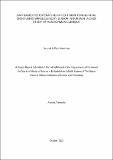IoMT BASED POSTOPERATIVE PATIENT MONITORING VITAL SIGNS USING WIRELESS BODY SENSOR IN BURUNDI: A CASE STUDY OF VAN NORMAN CLINIQUE
Abstract
The Internet of Things (IoT) in healthcare plays a vital role to increase the efficacity in health
care monitoring. Vital signals are crucial part of monitoring a patient's health status in the
hospital for early diagnosis of delayed recovery, asses wellbeing of the patient and prevent
misdiagnosis. During the postoperative period, vital signs must be checked more frequently
than they would be for other patients. Patients are placed in a high dependency unit, and vital
signs have to be checked every 4 hours, or 6 hours depending on the severity of the procedure
done. A comprehensive and integrated health-care paradigm is provided, allowing for remote
health monitoring of postoperative patients to diary collect vital sign parameters and send to
the caretakers using Internet of Medical Thing. This enables a nurse, doctor, junior doctor, or
consultant to screen patients remotely and take action when there is a need. Wireless body
sensors play a vital role in healthcare, this project uses them to monitor remotely a patient in
the hospital, connecting to the ESP32 microcontroller with WiFi integrated on it to display
remotely the vital signs on a mobile phone, local computer also in the cloud. The objective of
this project was to develop a smart IoMT-based monitoring system that can detect and monitor
postoperative patient vital signs such as body temperature, heart rate, oxygen saturation, and
respiration rate in real time, as well as send live data to the doctor in charge via mobile
application and analyze data using ThingSpeak.

